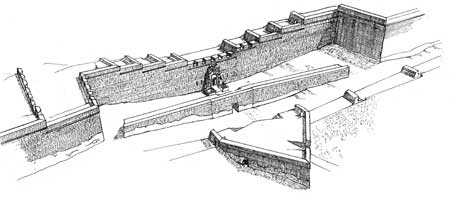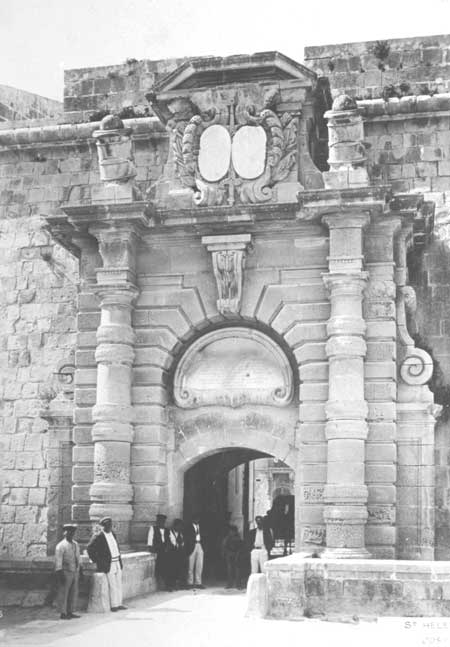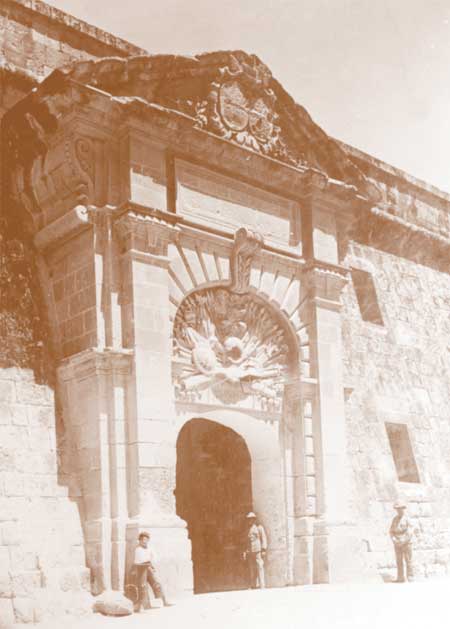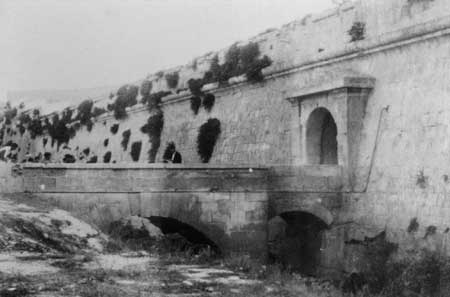 |
|
General layout of the Margherita, Firenzuola Lines
|
During the Great Siege, Birgu was commanded by the heights of Salvatore and Santa Margerita. For three months, twelve guns and two bombards pounded the Birgu land-front continuously, stopping only to allow their infantry to attack the ruined walls. These were repelled time and again by the guns and swords of the defenders.
After the Siege the crumbled fortifications were reconstructed to their original design and in 1588 the Cavaliers of St John and St James were erected on the two Vittoriosa bastions facing Bormla. However, according to Laparelli, even these extra fortifications were not enough to provide the required protection of Bormla and Galley Creek and he recommended their abandonment. However the Order could not accept this recommendation owing to the vital importance of Galley Creek for the shelter of its galleys and naval installations.
 |
 |
|
General view (top) and cross-section of the Lunette in front of the St. Helen's Curtain, Firenzuola Lines
|
In 1635 military engineer Pietro Paolo Floriani suggested the fortification of the Santa Margerita Heights by enclosing Cospicua within a strengthened line of defence that stretched from Vittoriosa to Senglea. The fortification plans were designed by Domenican friar and military engineer Vincenzo Marculano da Firenzuola in 1638. The defences were to comprise of five bastions and a demi-bastion that would be joined by long curtain walls linking the Vittoriosa and Senglea fronts. The foundation stone was laid on the 30th December 1638 – three years after the beginning of the Floriana fortifications. Works were suspended in 1645 because of lack of funds as priority was given to the completion of the Floriana Lines. By 1654 it was noted that Vittoriosa’s defences needed attention as parts of the main enceinte seemed to be on the verge of collapse and so work was resumed on the Santa Margerita Lines. These were more or less completed in 1671 and although they represented an unbroken trail of bastions, were still considered to be militarily defective.
 |
|
St. Helen's Gate (Porta dei Mortari)
|
The fortifications were once more reported to be almost in ruins in 1714 and so work was resumed again on the following year under engineer de Tigne. The construction of the Santa Margerita Lines was finally finished in 1736 – incidentally, after the completion of the Cottonera Lines – and despite the great effort, and heavy cost of time and resources that were involved, the Santa Margerita Lines were regarded as being militarily flawed and it was held that they would only be able to hold for a few days.
However the Santa Margerita Lines not only linked Vittoriosa and Senglea, removing them from the front line of attack and altering their role to that of a citadel, but they also encompassed a good part of Cospicua – thus taking the second step towards the establishment of the Cottonera Region.
 |
 |
|
Verdala Gate (left) and Sally Port (demolished)
that used to lead to Kalkara
|

